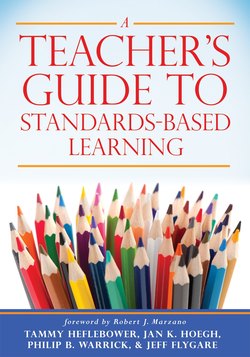Читать книгу A Teacher's Guide to Standards-Based Learning - Jan K. Hoegh - Страница 9
На сайте Литреса книга снята с продажи.
ОглавлениеForeword
by Robert J. Marzano
For decades, educators have been discussing standards-based assessment and grading. Indeed, as far back as the early 1990s, I and others were writing quite extensively about the impact the standards movement was likely to have on K–12 schooling. In this new book, Heflebower, Hoegh, Warrick, and Flygare revisit some of those topics but add the perspective of how standards should affect both teaching and learning. At the core of their discussions and recommendations are proficiency scales.
While the term proficiency scales is used in many different ways and has many different manifestations, the type of scale used by the authors goes back to my early work in the 1990s and is currently being used in every U.S. state, and a number of countries, to one degree or another. Such proficiency scales have been well vetted regarding their utility with assessment, grading, curriculum, and instruction.
To design this particular type of proficiency scale, educators must identify those topics from state or local standards that are essential for students’ academic success. The authors refer to this process as prioritizing the standards. The content within each of the essential topics derived from prioritized standards is then organized into a progression of knowledge embedded within the proficiency scale, which becomes the guaranteed curriculum within a school or district.
After establishing a firm foundation regarding the nature of and need for proficiency scales, the authors address how the scales can and should be used. First, and perhaps foremost, proficiency scales should be highly visible. Teachers should make students aware of the essential topics that they will address throughout the year and the content in the proficiency scales for each topic. This renders the curriculum completely transparent for students and parents. They know what will be taught throughout year, when it will be taught, and precisely what proficiency looks like for each topic.
Each proficiency scale also governs assessment. In fact, it is ideal if cooperative teams within the professional learning communities (PLC) process generate common pretests and posttests using the proficiency scales. Better yet, teachers in a collaborative team can score students’ pretests and posttests to determine individual student needs and calibrate the manner in which teachers design and score assessments based on proficiency scales.
Teachers should ask students to set goals regarding their learning of the content in specific proficiency scales. A powerful addendum to this process is encouraging students to track their progress over time on specific proficiency scales. In this way, both their current status and their growth can be the subject of celebration.
Classroom instruction and the planning of that instruction should be based on the proficiency scales addressed within a unit. The authors demonstrate that proficiency scales can serve this need regardless of the specific instructional model that a school or district uses. Grading and reporting should also revolve around scores on proficiency scales. The authors illustrate how teachers can translate standards-based student scores into traditional letter grades and percentage scores.
These are only a few of the issues the authors address in A Teacher’s Guide to Standards-Based Learning. Those readers familiar with standards-based education will recognize many topics but will surely find a fresh perspective on each. Those new to standards-based education will receive a clear picture of what it might look at the classroom level and from the perspective of the student.
